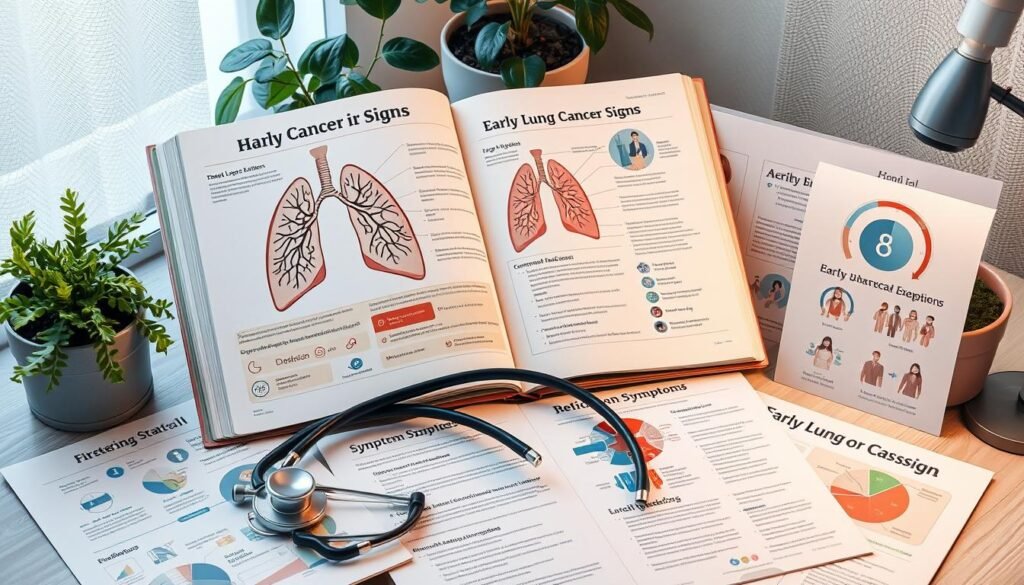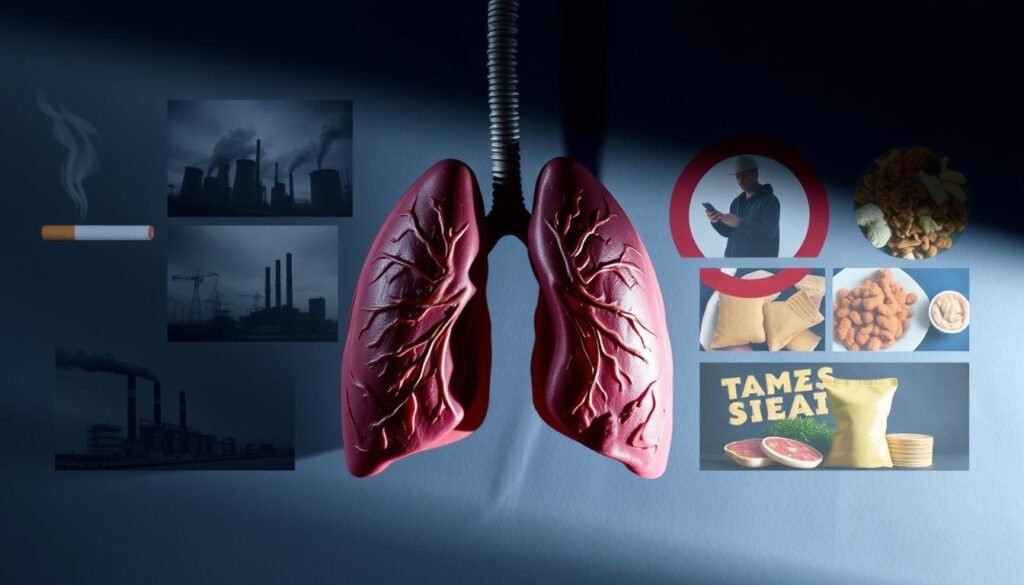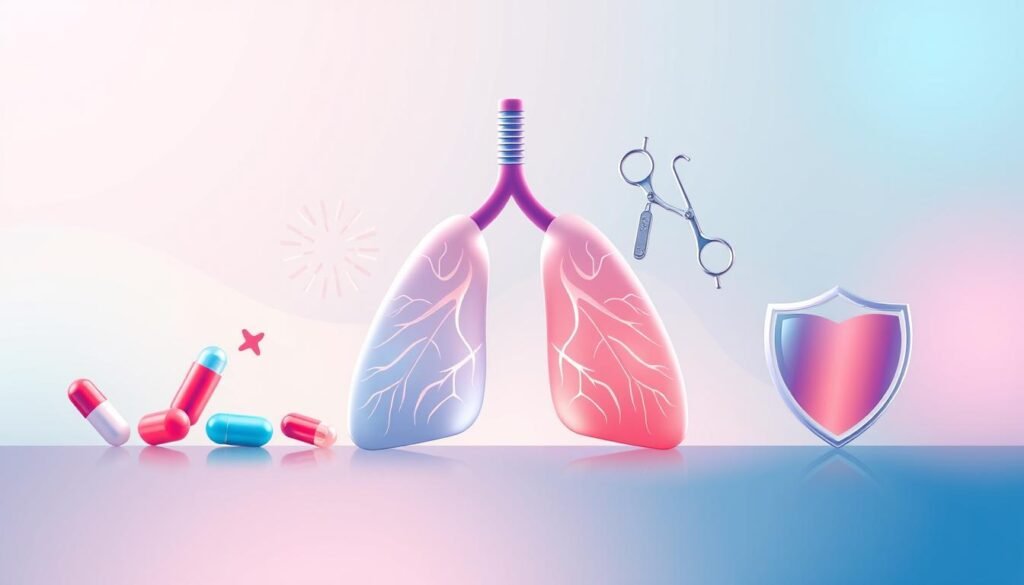Lung cancer tops as the deadliest cancer across the globe. It takes more lives yearly than breast, prostate, and colon cancers combined. Knowing the early signs of lung cancer is key. Spotting lung cancer early can greatly improve the chances of successful treatment and survival. It helps people to seek medical help early, possibly finding the disease when it’s easier to treat.
This guide focuses on spreading awareness about lung cancer’s critical signs and the power of knowledge in combatting this fatal disease. You’ll find helpful info on early lung cancer symptoms in this article. Plus, there are details on the various types of lung cancer and screening guidelines. Taking action early can save lives. Knowing the early signs is the first step to a hopeful future.
Key Takeaways
- Lung cancer stands as the biggest cancer killer worldwide.
- Spotting early symptoms of lung cancer can lead to quick doctor visits.
- Educational content is vital for raising lung cancer awareness.
- Finding lung cancer early can really improve chances of beating it.
- Knowing what increases your cancer risk can help avoid it.
Understanding Lung Cancer
Lung cancer is the third most common cancer in the United States. It comes after breast cancer in women and prostate cancer in men. Every year, about 235,000 new people find out they have it. This fact shows how vital lung cancer awareness is. Currently, over 611,000 people are living with lung cancer.
To really understand what lung cancer means, you need to know it starts in the lungs. It grows out of control and can destroy healthy lung parts. Smoking is the biggest cause, being behind 90% of cases. People who have stopped smoking also need to be careful. Almost 60% of people who get lung cancer used to smoke.
There are other things that can cause lung cancer too. This includes secondhand smoke, asbestos, and radon gas. It’s crucial to know these risks to prevent the disease. Also, lung cancer is more common in older adults. Most people who get diagnosed are 65 or older.
But there is hope if lung cancer is found early. People diagnosed at an early stage have a survival rate over 90%. That’s why regular screenings and learning about symptoms are key. The National Cancer Institute and the American Cancer Society offer a lot of info. They can teach you about lung cancer types and treatments. For deeper insights into lung cancer, click here to learn more about its nature and.
| Statistic | Data |
|---|---|
| New Cases Annually | 235,000 |
| Current Patients | 611,000 |
| Percentage from Smoking | 90% |
| Diagnosed Ex-Smokers | 60% |
| Older Patient Percentage | Over 66% |
| Initial Stage Survival Rate | 90%+ |
| Non-Small Cell Lung Cancer (NSCLC) | 85-90% |
| Small Cell Lung Cancer (SCLC) | 10-15% |
Types of Lung Cancer
Lung cancer is mainly split into two types: small cell lung cancer (SCLC) and non-small cell lung cancer (NSCLC). The type depends on what the cells look like under a microscope. Most lung cancer cases, about 85%, are NSCLC. This group includes a few different kinds, such as:
- Adenocarcinoma – makes up about 40% of NSCLC cases.
- Squamous cell carcinoma – is about 30% of NSCLC cases.
- Large cell carcinoma – this rare type is a small part of NSCLC.
The other main type, small cell lung cancer, is about 15% of cases. It grows quickly and is often found in heavy smokers. SCLC needs fast action for treatment. Knowing the difference between these types is critical. That’s because treatment strategies vary greatly between SCLC and NSCLC.
In some NSCLC cases, and occasionally in SCLC, surgery might remove the tumor. Chemotherapy is a common approach for both types and it’s usually given through an IV. Immunotherapy is another tactic. It exposes cancer to the immune system, helping the body to attack it. But, these treatments might affect how a patient feels day-to-day.
Early Signs of Lung Cancer
Knowing early signs of lung cancer can make a big difference, especially in non-smokers. These symptoms may look like other common respiratory issues. So, it’s important to know what signs to watch for in lung cancer, especially if you don’t smoke.
Common Symptoms in Non-Smokers
Spotting lung cancer in non-smokers can be tricky, but certain signs should not be ignored. These include:
- Chronic cough: A cough that lasts more than eight weeks should raise concerns.
- Unexplained weight loss: Losing weight suddenly without trying is a warning sign.
- Shortness of breath: Feeling short of breath during regular activities is not normal.
- Chest pain: Chest discomfort might signal a serious problem.
- Coughing up blood: This is a sign that always requires a doctor’s check.
Persistent Cough and Other Symptoms
A constant cough is a major symptom that deserves attention. If it doesn’t go away with usual treatments, it could mean the disease is getting worse. Lung cancer also shows symptoms like:
- Hoarseness: A change in voice tone can happen as the condition progresses.
- Frequent respiratory infections: People may get pneumonia or bronchitis more often.
- Wheezing: Hearing a whistling sound when breathing is a possible sign.
- Clubbing of fingers: Notably, 80% of individuals with clubbed fingers are diagnosed with lung cancer.
For a deeper insight on this, checking out more about signs of lung cancer is helpful. Being aware of these signs can lead to early detection and timely treatment.
Educational Resources on Early Lung Cancer Signs
Finding educational resources on early lung cancer signs is crucial for those who want to learn about this illness. The American Cancer Society has lots of information on topics like screening, diagnosing, and treatment options. With these resources, people can better understand lung cancer and take charge of their health.

- Understanding lung nodules and their implications
- Biopsies and biomarker testing for personalized treatment plans
- Targeted therapies and immunotherapy options
- Palliative care and management of side effects
- Clinical trials and their significance in treatment
Resources cover both non-small cell lung cancer (NSCLC) and small cell lung cancer (SCLC) in detail. They help patients understand each stage of cancer, from stage 1 to stage 4, and SCLC stages. These materials make the stages and treatment options clearer.
Support programs are vital in lung cancer education and help. For example, the LungMATCH and Phone Buddy Programs support those diagnosed by providing information and emotional support. LUNGevity’s Lung Cancer HELPLine offers personalized help on weekdays, helping patients feel less alone.
| Program Name | Description |
|---|---|
| LungMATCH Program | Connects patients with others who share a similar diagnosis for emotional support. |
| Phone Buddy Program | Offers companionship and assistance through one-on-one phone calls. |
| Small Cell Lung Cancer Program | Focuses on resources specific to small cell lung cancer patients. |
| Lung Cancer Registry | Collects data to help improve treatment and support options for lung cancer patients. |
Increasing awareness and support for lung cancer can empower those affected. Lung cancer support resources provide much-needed practical and emotional help. They ensure that patients, caregivers, and families can navigate their journey with support.
The Importance of Early Detection
Early detection of lung cancer is key to better treatment results and higher recovery chances. Studies show that early stage lung cancer detection boosts survival rates. For example, stage IA lung cancer patients have a survival rate over 90%. But, this rate drops below 10% for those diagnosed at stage IV. This shows how vital early lung cancer screening is.
Even with low-dose CT (LDCT) scans available, that lower lung cancer death risk by 20-25%, many don’t use these screenings. Sadly, only half of the people eligible for colorectal cancer screenings actually go. And even fewer people get checked for lung cancer early on.
Location affects lung cancer diagnosis rates too. Over 36% of those in areas with high lung cancer deaths travel an hour for screenings. This makes it hard for many to get screened on time.
Many don’t get screened because they are not aware or can’t access services. This is especially true for heavy smokers and less privileged groups. They often are not told about early screening benefits. By improving education and resources, we could make healthcare more fair.
Talking well with healthcare providers matters a lot. When doctors and patients make decisions together, people are more likely to get screened. This way, they know the benefits and risks of screening. To learn more about when and how to get screened, check out this educational guide.
Risk Factors Associated with Lung Cancer
Lung cancer is the second most common cancer in the United States. Knowing the risk factors is key to prevention. Smoking is the top cause, but other elements also play a role.
Smoking and Secondhand Smoke Effects
Smoking greatly increases lung cancer risk. It affects smokers and those around secondhand smoke. Tobacco’s carcinogens harm lung cells, making cancer more likely. Over 60% of lung cancers in the UK are due to smoking. This highlights the importance of reducing smoking’s impact.
Family history of lung cancer also increases risk. People with this background should get regular checks and take preventive steps.
Environmental and Genetic Factors
Environment plays a big part in lung cancer risk. Radon gas, asbestos, uranium, and air pollution are key factors. Outdoor air pollution causes about 8% of cases in some areas. It poses a risk to many people.
Certain jobs, like construction or working with diesel exhaust, raise cancer risks due to exposure. Genetics can also increase vulnerability, even without direct risk factors. To learn more, visit this link.

Lung Cancer Screening Guidelines
It’s crucial for certain people to get regular checks for lung cancer. The main advice is for folks who smoked a lot over the years. The goal is to find lung cancer early which can help a lot with treatment.
Who Should Get Screened?
The American Cancer Society says people 50 to 80 years old should get a yearly scan if they smoked a lot before. A “pack-year” means smoking 20 cigarettes every day for a year. Even people who stopped smoking can get lung cancer, even years later. Because of this, it’s a good idea to check even those who quit over 15 years ago.
Types of Lung Cancer Screening Tests
The best way to look for lung cancer is with a low-dose CT scan. These scans are clear but don’t expose you to much radiation. There are also other tests available depending on what a person might need.
Knowing the latest advice on checking for lung cancer helps people make smart health choices. Doctors now think more people should be checked to help catch cancer early.
| Age Group | History of Smoking | Recommended Screening Test |
|---|---|---|
| 50-80 years | 20 pack-years | Yearly low-dose CT scan |
| Former Smokers | Quit for more than 15 years | Considered for screening based on risk |
Lung Cancer Treatment Options
Lung cancer comes with challenges, but knowing your treatment options can really help. The type and stage of cancer play a big role in deciding treatment. Often, doctors use a mix of treatments to get the best results for lung cancer patients.
Overview of Treatment Methods
Common lung cancer treatment options typically include:
- Surgery: Often recommended for early-stage lung cancer, surgery may involve removing part or all of the lung.
- Chemotherapy: This treatment uses drugs to kill cancer cells and is commonly used in various stages.
- Radiation therapy: High-energy rays target cancer cells, often utilized in conjunction with other treatments.
- Targeted therapies: These medications specifically target genetic changes in cancer cells, aiming to block their growth.
- Immunotherapy: This approach helps the immune system recognize and attack cancer cells.
- Palliative care: Focused on comfort and quality of life, this option is crucial for advanced stages of the disease.
Lung cancer treatment options depend on each person’s unique situation. Talking with healthcare professionals is key to finding the right approach. For more info, you can check out lung cancer diagnosis and treatment information.
Importance of a Personalized Treatment Plan
Having a personalized treatment plan is vital for lung cancer care. It takes into account genetic factors, personal preferences, and overall health. This increases the chance of successful treatment. Discussing options and benefits of therapies with oncologists is key.
What works for one patient might not work for another. So, personalized treatment plans make sure everyone gets the therapy that fits their unique needs best.

| Treatment Method | Purpose | Common Use Cases |
|---|---|---|
| Surgery | Remove tumors or affected lung tissues | Early-stage lung cancer |
| Chemotherapy | Kills cancer cells with drugs | Various stages, including metastasized cancer |
| Radiation Therapy | Targets and shrinks tumors | Often used for localized treatment |
| Targeted Therapy | Directly attacks cancer’s genetic mutations | Specific genetic markers present |
| Immunotherapy | Enhances the body’s immune response | Advanced stages and specific tumor types |
| Palliative Care | Improves quality of life | Late-stage lung cancer |
Lung Cancer Prevention Strategies
Lung cancer prevention includes lifestyle changes and environmental awareness. These strategies help lower lung cancer risk and improve health.
Quitting Smoking and Its Benefits
Quitting smoking is key for lung health. Stopping smoking at any age cuts lung cancer risk and adds years to your life. Despite being the main cause of lung cancer, quitting smoking can turn the tide, showing how lifestyle choices impact health.
Reducing Environmental Risks
Environmental factors also affect lung cancer risk. Testing and fixing radon issues in homes is crucial. Reducing exposure to air pollution and harmful chemicals is important too. Eating lots of fruits and vegetables supports lung health and lowers cancer risk. Together, these steps lead to healthier living.
| Strategy | Description | Impact on Lung Cancer Risk |
|---|---|---|
| Quit Smoking | Stopping smoking reduces exposure to harmful chemicals. | Significantly decreases lung cancer risk. |
| Radon Testing | Testing homes for radon and addressing high levels. | Helps reduce risk related to radon exposure. |
| Healthy Diet | Consuming fruits and vegetables as part of a balanced diet. | May aid in lowering overall lung cancer risk. |
| Avoid Carcinogens | Limiting exposure to known cancer-causing agents. | Helps minimize potential lung cancer risk factors. |
Conclusion
Lung cancer awareness is key in battling this deadly disease. In the U.S., it’s the top reason for cancer deaths. Knowing early signs like ongoing cough, losing weight, and feeling tired can save lives.
This guide shows why it’s urgent for people, mainly those at risk, to get checked early. Even though only 6.6% got screened in 2019, newer screening ways are better. They make fewer mistakes and spot cancer sooner. Risk factors like smoking and family history tell us who should be careful.
Education and awareness efforts help everyone take control of their health. As we learn more, we stand a better chance against lung cancer. It’s important for all to know the symptoms and act early. This could make a big difference.